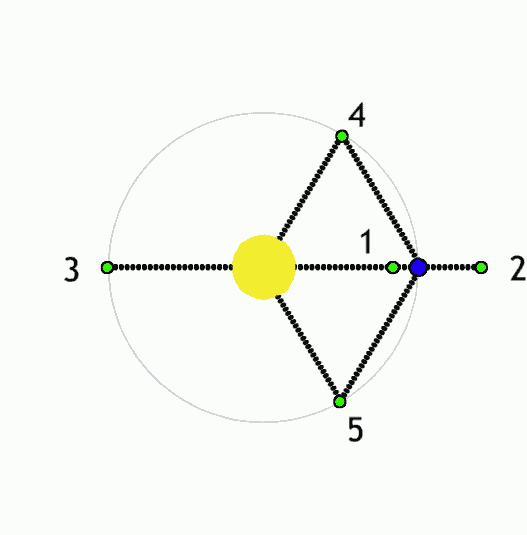Mars is accompanied by a pair of small moons — Phobos and Deimos — as well as four Trojan asteroids that follow the Red Planet in its trips around the Sun.
Trojan asteroids follow planets, including Mars, Earth, and Jupiter, placed 60 degrees ahead of or behind their worlds. This angle provides stable gravitational points in the orbit for the asteroids as they move around the Sun. Each orbit of two massive objects produces five places, known as Lagrange (or Lagrangian) points, where gravity of the two larger objects balances, keeping smaller bodies in a stable orbit around a central point.
Those bodies 60 degrees ahead of planets are known as leading Trojans (#4 on the diagram), while those behind their planetary parent are denoted as trailing Trojans (#5).
The trailing trojans following Mars through space are known as the Eureka family of asteroids, named in honor of 5261 Eureka, the first of these bodies found in the orbit of Mars. Astronomers believe most of these objects fragmented off a large parent body.
However, one of these asteroids — (101429) 1998 VF31 — appears to be different from its stony compatriots.
One of these things is not like the other…
Astronomers from the Armagh Observatory and Planetarium (AOP) in Northern Ireland examined these Eureka bodies. Spectrographs made using the X-SHOOTER instrument attached to the eight-meter Very Large Telescope (VLT) in Chile uncovered a secret.
While other bodies in the Eureka group were similar to each other, 101429 is far different. However, it does resemble another body in the Solar System — our own Moon.
“Many of the spectra we have for asteroids are not very different from the Moon but when you look closely there are important differences, for example, the shape and depth of broad spectral absorptions at wavelengths of 1 and 2 microns. However, the spectrum of this particular asteroid seems to be almost a dead-ringer for parts of the Moon where there is exposed bedrock such as crater interiors and mountains,” explains Dr. Galin Borisov of Armagh Observatory and Planetarium.
This asteroid, perhaps a kilometer across, regularly crosses the orbit of Mars as it revolves around the Sun once every 687 days.
The 101429 trojan asteroid was also found to contain more iron than its brethren, and higher levels of proxenes — a class of long-chain molecules found in many igneous and metamorphic rocks here on Earth.
This origin story rocks
This discovery begs the question — “Where did this asteroid originate?” Researchers have several theories, although none are yet certain.
“The asteroid could be genetically related to iron-rich primitive achondrite meteorites, may have originated as impact ejecta from Mars — a scenario proposed recently for the Eureka family asteroids — or could represent a relic fragment of the Moon’s original solid crust, a possibility raised by the asteroid’s close spectral similarity to areas of the lunar surface,” researchers describe in an article detailing the study, published in the journal Icarus.
[embedded content]
Analysis of the data suggests that 101429 was likely ejected from Mars, a large asteroid, or — possibly — our own Moon.
“The early solar system was very different from the place we see today. The space between the newly-formed planets was full of debris and collisions were commonplace. Large asteroids — we call these planetesimals — were constantly hitting the Moon and the other planets. A shard from such a collision could have reached the orbit of Mars when the planet was still forming and was trapped in its Trojan clouds,” states Dr. Apostolos Christou, an astronomer at AOP.
The vast majority of trojans in our solar system — thousands, in fact — are found in the gravitational field of Jupiter. These bodies are thought to be leftover from the formation of the Solar System.
In 2010, an asteroid was discovered following Earth which was initially believed to be a trojan body accompanying our own planet. However, this asteroid — 2010 TK7 — was a member of the Asteroid Belt which broke free, temporarily following Earth in an unstable orbit.
Trojans in the same orbit as Earth are more difficult to find than those around other worlds. Their positions relative to Earth require telescopes looking for them to point close to the Sun, which most telescopes cannot withstand.
The Vera C. Rubin Observatory, with an 8.4 -meter telescope, will soon be searching the skies for signs of Earth-based trojans. The Lucy spacecraft, due for launch in 2021, will be the first robotic explorer to examine trojan bodies up close when it arrives at its destination at the orbit of Jupiter. These new studies could help us better understand the nature of these little-known bodies in our solar system.
This article was originally published on The Cosmic Companion by James Maynard, founder and publisher of The Cosmic Companion. He is a New England native turned desert rat in Tucson, where he lives with his lovely wife, Nicole, and Max the Cat. You can read this original piece here.
Astronomy News with The Cosmic Companion is also available as a weekly podcast, carried on all major podcast providers. Tune in every Tuesday for updates on the latest astronomy news, and interviews with astronomers and other researchers working to uncover the nature of the Universe.
Read next: At just 2.2MB, Google’s new speech filtering tech is perfect for mobile apps


